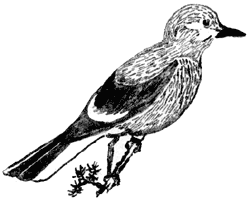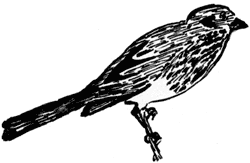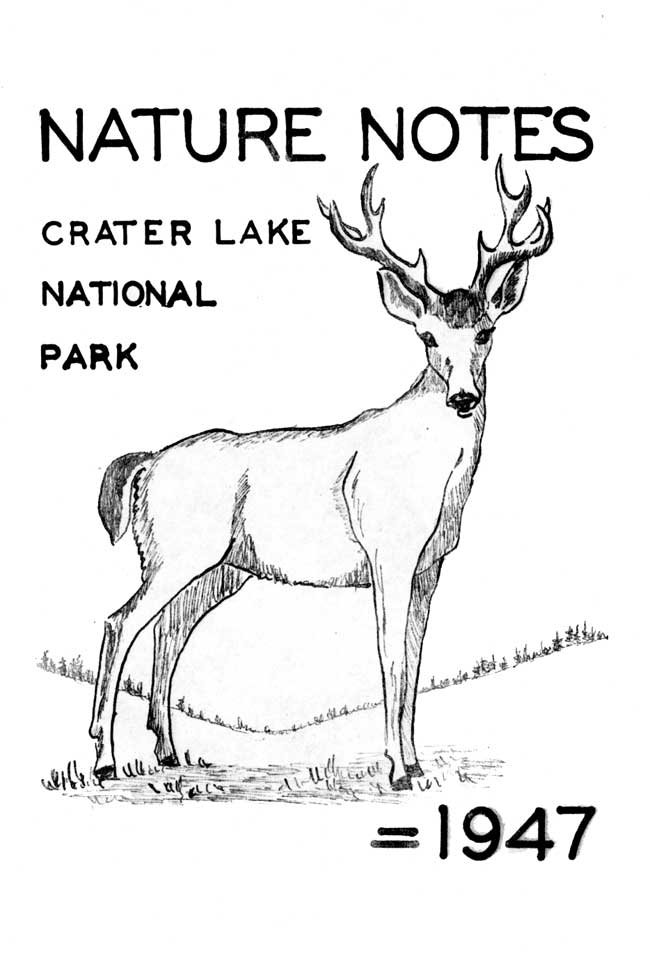Volume 13, October 1947
All material courtesy of the National Park Service.These publications can also be found at http://npshistory.com/
Nature Notes is produced by the National Park Service. © 1947
During three different summer seasons a mother Clark’s Crow, Nucifraga columbiana,has arrived on Crater Lake rim with a full grown but dependent young one. The 1942 pair, on which notes were taken, kept close to the parking area, the mother availing herself of the food offered by visitors and the young one calling incessantly to share in it.
 On July 13, 1947, the writer observed four Clark’s Crows on a table in the picnic area. One adult flew away leaving an adult with two full grown and clamorous offspring. The mother gleaned under the table for awhile, both young hopping after her with hunger cries.This perpetual clamor during the first part of July interested many people, most of whom appreciated the fact that they were observing a somewhat uncommon episode in family relations although few realized how unseasonal it was for a nutcracker to be feeding young that late in the year. In the morning, the mother usually exhibited considerable patience with her nagging offspring and fed it diligently. By afternoon, however, she appeared distinctly weary of well-doing, fed only at long intervals, and flew rapidly from one perch to another followed interminably by the squawking young one. At times she would administer a weaning peck or two which appeared to have little effect, and sometimes, when the youngster’s mouth was open, she would “feed him her bill clear down to the gizzard,” as one onlooker phrased it. This produced a sort of choking gurgle in the young one and greatly pleased visitors who were very tired of his clamor.
On July 13, 1947, the writer observed four Clark’s Crows on a table in the picnic area. One adult flew away leaving an adult with two full grown and clamorous offspring. The mother gleaned under the table for awhile, both young hopping after her with hunger cries.This perpetual clamor during the first part of July interested many people, most of whom appreciated the fact that they were observing a somewhat uncommon episode in family relations although few realized how unseasonal it was for a nutcracker to be feeding young that late in the year. In the morning, the mother usually exhibited considerable patience with her nagging offspring and fed it diligently. By afternoon, however, she appeared distinctly weary of well-doing, fed only at long intervals, and flew rapidly from one perch to another followed interminably by the squawking young one. At times she would administer a weaning peck or two which appeared to have little effect, and sometimes, when the youngster’s mouth was open, she would “feed him her bill clear down to the gizzard,” as one onlooker phrased it. This produced a sort of choking gurgle in the young one and greatly pleased visitors who were very tired of his clamor.
She then fed one young by regurgitation, ate again herself, and fed the second young crow in a similar manner. Occasionally, the mother fed both young in succession without eating between feedings. Both young accepted food with the typical feeding reaction of throaty noises and quivering wings. On July 18, 1947, three crows presumably the same trio, were in the camp grounds and going through the same maneuvers. The young made no effort to feed themselves when food was available.
To observe birds that nest, as a rule, in March, feeding young in the latter part of July is sufficiently unseasonal to be made a matter of record. In all three previous seasons in which it has been observed, the phenomenon was confined to one family. Data upon marked birds have shown that Clark’s Crows return to Crater Lake Rim for several years in succession so the observed adult may have been the same bird. She may nest much later than modally or she may rear an atypical second brood and bring one or more of them to the lake. Another possibility is that in a related group of birds the mother-young relationship is continued in time to a pathological degree and we are observing the distasteful antics of the crow problem child. In this connection, it may be recalled that problem children are an excrescence of the higher classes, a group, amongst avians, in which the crows belong. The idea should interest the philosopher who believes that the larger social groups are merely extensions of family relationships which were not, in themselves, particularly salutary. Other observations of mother-young interactions similar to those described above would be of interest in this connection.
Fox Sparrows Breeding on the Rim
By Dr. R. R. Huestis, Ranger-Naturalist
On July 30, Park Naturalist George C. Ruhle identified a fox sparrow, Passerella iliaca,sub. sp., on the rim walk just east of Crater Lake Lodge. The writer, who was a member of the field party being led by Mr. Ruhle, went back to the area on the morning of July 1 to see if the bird was still there. This special trip was prompted by knowledge of the fact that fox sparrows had not been reported even as transients in the rim area during the seven summers in which the writer has been a seasonally employed ranger-naturalist at Crater Lake National Park.
 This female was carrying food and while the writer watched she signaled out of cover and fed a young bird apparently in juvenile plumage. After an interval of about two minutes the female reappeared with food, made contact with, and fed a young bird this time in the cover of a clump of small mountain hemlocks and herbaceous shrubs close to the rim walk. The observer was within twenty feet of the birds involved in these two important episodes in the lives of avian young.On July 1 at 8:30 A.M. a singing male, presumably the one identified by Mr. Ruhle, was seen on a small mountain hemlock close to the rim walk; near him was a female, presumably the second bird that was heard but not observed the previous day.
This female was carrying food and while the writer watched she signaled out of cover and fed a young bird apparently in juvenile plumage. After an interval of about two minutes the female reappeared with food, made contact with, and fed a young bird this time in the cover of a clump of small mountain hemlocks and herbaceous shrubs close to the rim walk. The observer was within twenty feet of the birds involved in these two important episodes in the lives of avian young.On July 1 at 8:30 A.M. a singing male, presumably the one identified by Mr. Ruhle, was seen on a small mountain hemlock close to the rim walk; near him was a female, presumably the second bird that was heard but not observed the previous day.
A prior report upon Passerella within Crater Lake National Park was made by Joseph Dixon who collected a fall migrant Valdez Fox Sparrow in 1936. The present family group was not broken to provide a bird in hand. The probability is that this report concerns P. I. fulva, Warner Mountains Fox Sparrow.



